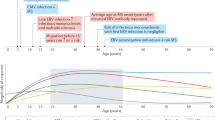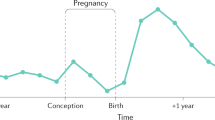Abstract
Purpose
To report the association of severe chorioretinal dysplasia, hydranencephaly, microcephaly, and intracranial calcification in children with no evidence of intrauterine infections.
Methods
Two unrelated female infants with visually inattentive behaviour, hydranencephaly, and intracranial calcification were referred for an ophthalmological opinion.
Results
The fundus examination and computerised tomograms (CT scans) of head were similar in both children. There was bilateral extensive chorioretinal dysplasia, intracranial calcifications, and hydranencephaly. Serology was negative for acquired intrauterine congenital infections.
Conclusions
We report two cases that may represent a new syndrome or the more severe end of the spectrum of the pseudo-TORCH (toxoplasma, rubella, cytomegalovirus, and herpes simplex) syndrome. The association of chorioretinal dysplasia with the pseudo-TORCH syndrome has not been reported previously.
Similar content being viewed by others
Introduction
The pseudo-TORCH syndrome, an autosomal recessive condition, is characterised by central nervous system findings similar to those seen in intrauterine infections, but with negative serological tests for the typical TORCH infections (toxoplasmosis, rubella, cytomegalovirus, herpes, syphilis).1 Ophthalmologic abnormalities have not been consistently recognised in patients with the pseudo-TORCH syndrome.1, 2
This report describes the association of hydranencephaly, intracranial calcifications, and chorioretinal dysplasia, which to our knowledge has not been reported previously.
Methods
Case 1
A 7-week-old female infant with roving eye movements was referred for ophthalmic evaluation. The mother had weakly positive immunoglobulin G (IgG) titres for CMV and herpes, and negative titres for rubella, toxoplasmosis, and syphilis. An antenatal computed tomography (CT) scan demonstrated hydranencephaly at 29 weeks.
The child had delayed developmental milestones, hypertonic reflexes, and a bilateral sensorineural hearing impairment. At 6 weeks, her head circumference had increased to 41 cm, which required a ventriculoperitoneal shunt to prevent the hydranencephaly from expanding.
Ophthalmic examination revealed no visual responses to light in both eyes. Fundus examination revealed some vitreous haze with bilateral optic nerve hypoplasia, attenuated retinal vasculature, diffuse chorioretinal atrophy, pigment clumping, and a dysplastic retina (Figure 1a and b). A clinical diagnosis of a possible intrauterine infection was considered in view of the fundus findings.
The creatine kinase (CK) level was 54 IU (normal 0–190 IU). Computerised scanning of the brain demonstrated hydranencephaly, an absent corpus callosum, and periventricular intracranial calcifications (Figure 1c). Urine for CMV and serum TORCH screens were both negative. Chromosomal analysis revealed a normal female karyotype.
Case 2
An unrelated 8-day-old female infant was referred for ophthalmic evaluation. She was the first child of healthy, unrelated parents, and was born at term by spontaneous, uncomplicated vaginal delivery. Her medical history was significant for the presence of hydranencephaly diagnosed antenatally and bilateral talipes equinovarus.
Ocular examination revealed poor fixation following responses to light. Fundus examination showed bilateral optic nerve and macular hypoplasia, pigment clumping, extensive chorioretinal atrophy, and retinal dysplasia (Figure 2a and b). Cycloplegic refraction revealed a moderate myopia (−4.0 D) in both eyes.
CK level was mildly elevated at 222 IU (normal 0–190 IU). CT of the brain demonstrated microcephaly, hydranencephaly, lissencephaly, lobar holoprosencephaly, and multiple, coarse, periventricular calcifications (Figure 2c). TORCH serology did not suggest an intrauterine infection, and chromosomal analysis revealed a normal karyotype.
Discussion
Hydranencephaly, a congenital anomaly, has been hypothesised to occur owing to vascular insufficiency related to malformations or intrauterine infections. Optic nerve aplasia, absent retinal vessels, pigment epithelial abnormalities, and chorioretinitis have been reported with hydranencephaly.3, 4, 5 Extensive chorioretinal dysplasia, as seen in our cases, has not been described with hydranencephaly.
The diagnostic significance of intracranial calcification may be indicated by its location, intrauterine infections commonly associated with periventricular calcification and basal ganglia calcification with mitochondrial disease, although these sites of calcification may be seen in a number of other conditions and are not pathognomonic of a particular disease process. The location of calcification in our cases was periventricular, as has been described in intrauterine infections and in the pseudo-TORCH syndrome.
Anterior segment anomalies and retinal dysplasia have been described with muscle-eye-brain disease, Walker–Warburg syndrome, and Fukiyama congenital muscular dystrophy where congenital muscular dystrophy and lissencephaly features are prominent. In case 2, lissencephaly was associated with hydranencephaly and intracranial calcifications. The triad of chorioretinal lacunae, complex brain abnormalities including corpus callosum agenesis, and infantile spasms in female children constitute the diagnosis of Aicardi syndrome.6 The diffuse chorioretinal changes with hydranencephaly and the absence of infantile spasms make this diagnosis unlikely.
The pseudo-TORCH syndrome is characterised by microcephaly, spasticity, seizures, developmental delay, and intracranial calcification and negative laboratory workup for acquired intrauterine infections.2 However, none of the patients reported with this condition have been described to have fundus abnormalities. Microphthalmia and cataracts have been reported with pseudo-TORCH syndrome5(Table 1).
In summary, the cases presented have some features similar to the MEB syndrome, WWS, FCMD, Aicardi syndrome, and the pseudo-TORCH syndrome. However, the characteristic diffuse chorioretinal dysplasia with poor vision, associated with extensive hydranencephaly, intracranial calcifications, and developmental delay, makes these two cases distinctive. As far as we are aware, this is the first series to report an association of hydranencephaly, intracranial calcifications, and chorioretinal dysplasia and may represent part of a continuing spectrum of pseudo-TORCH or a new syndrome.
References
Vivarelli R, Grosso S, Cioni M, Galluzzi P, Monti L, Morgese G et al. Pseudo-TORCH syndrome or Baraitser–Reardon syndrome: diagnostic criteria. Brain Dev 2001; 23 (1): 18–23.
Knoblauch H, Tennstedt C, Brueck W, Hammer H, Vulliamy T, Dokal I et al. Two brothers with findings resembling congenital intrauterine infection-like syndrome (pseudo-TORCH syndrome). Am J Med Genet A 2003; 120 (2): 261–265.
Hill K, Gogan DG, Dodge PR . Ocular signs associated with hydranencephaly. Am J Ophthalmol 1961; 51: 267–275.
Manschot WA . Eye findings in hydranencephaly. Ophthalmologica 1971; 162 (3): 151–159.
Storm RL, PeBenito R . Bilateral optic nerve aplasia associated with hydranencephaly. Ann Ophthalmol 1984; 16 (10): 988–992.
Aicardi J . Aicardi syndrome. Brain Dev 2005; 27 (3): 164–171.
Author information
Authors and Affiliations
Corresponding author
Rights and permissions
About this article
Cite this article
Watts, P., Kumar, N., Ganesh, A. et al. Chorioretinal dysplasia, hydranencephaly, and intracranial calcifications: pseudo-TORCH or a new syndrome?. Eye 22, 730–733 (2008). https://doi.org/10.1038/sj.eye.6703058
Received:
Revised:
Accepted:
Published:
Issue Date:
DOI: https://doi.org/10.1038/sj.eye.6703058
Keywords
This article is cited by
-
Hydranencephaly: cerebral spinal fluid instead of cerebral mantles
Italian Journal of Pediatrics (2014)





